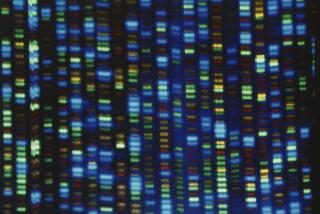Brigham Young’s on the Trail of DNA Tales
- Share via
Two tablespoons of blood drawn from each of 100,000 volunteers will soon help Brigham Young University researchers create a DNA database and trace family trees back 15 generations.
Officials with the high-tech genealogy project have traveled to Southern California several times during the last year to collect blood from locals who can trace their family histories back at least four generations.
Researchers will analyze the blood for DNA genetic markers that are identifying characteristics of individuals. Researchers also will collect family histories. The information will be entered into a database. Later, if two individuals are found to have similar genetic markers, the two most likely are related.
In its next search for area volunteers, the team will come to the Orange County Fair. From July 21 through July 26, researchers will hand out information and family-history forms and make appointments to take blood samples at Orange County locations.
It will take five years and tens of millions of dollars for the university’s Molecular Genealogy Research Group to complete the database of DNA samples and matching family trees. Researchers say when their work is completed, they will be able to use a blood test to tell most people where their genes have been over the last 300 years.
“Our goal is to create the world’s largest collection of genetic and genealogical information and then put that information into a database than can be used for understanding our connections with each other,” said Scott R. Woodward, microbiology professor and project director.
Woodward said the research is independent of the Church of Jesus Christ of Latter-day Saints, a major backer of genealogical work and the church with which Brigham Young University is affiliated. Hundreds of Mormons have volunteered to help with the project. Mormons are interested in genealogy because they believe that “vicarious baptisms for the dead” can be done to unite, for eternity, deceased relatives, who weren’t originally church members, with their family.
Nearly 25,000 blood samples have been collected in little more than a year. Researchers say they hope to obtain 200 samples each from 500 communities throughout the world.
Project officials began with members of genealogical societies, Mormons and others who already had extensive written family histories, some dating back as far as 800 years. By getting these people’s blood samples, the researchers can analyze their genetic markers.
Once the extensive sampling is finished, scientists will be able to pinpoint when a particular strand of DNA from almost anyone--and therefore a potential ancestor--was in a particular village.
People who use the database will not be able to immediately find out the names of distant relatives, since identifying information will not be made available. What they will get is information such as someone with their genetic markers was in Madrid in the year 1874 or in Cairo in 1790.
With those facts, the genealogical paper trail narrows considerably.
“The whole concept of DNA tracing in genealogy is very exciting and will let us solve long-standing mysteries,” said Michael Leclerc with the New England Historic Genealogical Society, a leading genealogical group. “It’s a double-edged sword, however. There’s also potential to disprove lineages too.”
If enough money is available, genetic genealogy tracing is achievable, said Stanley Nelson, associate professor of human genetics at UCLA.
“Ultimately, it’s absolutely doable,” Nelson said. “The basic notion that we’re all related is absolutely true.”
Brigham Young researchers are aware of the fear of a central agency possessing a huge database of DNA fingerprints. Project director Woodward said the researchers have tried to overcome Big Brother concerns by setting up a system to guarantee anonymity, in which codes, locations and dates take the place of family names.
“People are nervous about where the direction of human identification is going,” Woodward said. “Our top priority is confidentiality.”
The Brigham Young project is using more than 250 genetic markers to identify ancestry. The projected cost for identifying the markers is about $25 million, though new technology could substantially reduce that bill.
The university project is primarily funded by two philanthropists: Utah entrepreneur and medical-products pioneer James L. Sorenson and Arizona philanthropist Ira Fulton.
“As corny as it sounds, the reason they got involved in this project is to show how connected we all are,” Woodward said. “The words they use over and over again to describe what the research promotes are ‘unity,’ ‘brotherhood’ and ‘understanding.’ ”
People who search for their roots once Brigham Young’s database is complete will get the names of countries and villages in which their ancestors lived, along with dates. They also may be able to determine a family lineage that will be identified by a number, not by a surname.
The service will be available to the public.
“The turnaround time will be a matter of days or weeks,” Woodward said.
Genealogy buffs say the information will help reconstruct family trees whose branches have been cut off by runaway fathers, missing records or faded memories. It will also aid societies that never had name-based genealogies.
Scholars have used similar technology to trace human migration patterns and track diseases.
“It’s a whole different spin on genealogy,” said Carolyn Goates, a Newport Beach resident and Mormon who said she traced her family heritage to 1200. Goates already has provided a blood sample to the project.
“It will give you more clues,” she said.
Tracing genetic markers will be the way family histories are composed in years to come, said Russ Henderson of the National Genealogical Society.
“In the future, that will be the way we do genealogy,” Henderson said. “But we’re probably 100 years away.”
Genetic tracing also can be brutally honest and offer some unwanted surprises. A man who believed he was descended from Delaware colonist Timen Stiddem recently learned he isn’t.
More to Read
Sign up for Essential California
The most important California stories and recommendations in your inbox every morning.
You may occasionally receive promotional content from the Los Angeles Times.










